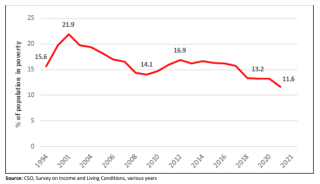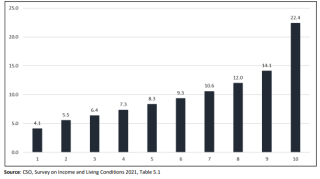Towards Wellbeing For All - Income and Wealth

The Programme for Government acknowledged that our “existing measures of economic performance fail to measure matters such as damage to the environment and voluntary work. They also overlook equality of opportunity, distribution of wealth and income and only value public expenditure on the basis of the inputs used, not the outcomes achieved” and committed to introducing a series of indicators that would more accurately measure wellbeing to provide a “holistic view of how our society is faring”.
A ‘Wellbeing Dashboard’ was then developed to provide a snapshot of progress. In developing the Dashboard, the Inter-Departmental Working Group established a list of 35 indicators chosen to be balanced, add value or be of policy relevance, provide for aggregation and dis-aggregation, be readily available and of sufficient quality, and be internationally comparable.
So how are we doing? To gauge public opinion on what matters, and what should therefore be counted as an indicator of Well-being, Social Justice Ireland produced a survey asking people to rank a set of six indicators under each of the Well-being Framework dimensions from one to six, with one being the least important and six being the most important. The six indicators included the indicators used in the Dashboard and datasets readily available from the CSO and other reputable sources. This survey was circulated over the Summer months through our social media channels, our Weekly Digest, and our Members Bulletin. What follows is based on the responses to this survey and our policy proposals under each of the 11 dimensions.
The period from 2016 onwards has been one of notable decline in the level of poverty. This has seen the proportion of the population in poverty fall from 16.2 per cent in 2016 to 11.6 per cent in the latest SILC survey (Chart 1).
Chart 1: At Risk of Poverty Rate

Social Justice Ireland warmly welcomes this progress. We therefore regret choices made in more recent budgets where increases to core welfare rates did not keep pace with inflation. From a European perspective, Eurostat produces comparable ‘at risk of poverty’ figures (proportions of the population living below the poverty line) for each EU member state. The latest data available for all member states is for the year 2021 when the average risk of poverty in the EU-27 was 16.8 per cent. Ireland has a below average risk of poverty when compared to all other EU member states.
The most recent data on Ireland’s income distribution, from the 2021 SILC survey, is summarised in Chart 2. It examines the income distribution by decile starting with the 10 per cent of individuals with the lowest income (the bottom decile) up to the 10 per cent with the highest income (the top decile). The data presented is equivalised, meaning that it has been adjusted to reflect the number of adults and children in a household and to make it possible to compare individuals located in households of different sizes and compositions. It measures disposable income which captures the amount of money available to spend after receipt of any employment/pension income, payment of all income taxes, and receipt of any welfare entitlements. In 2021, the top 10 per cent of the population received more than one fifth of the total income while the bottom decile received just 4.1 per cent. Collectively, the poorest 50 per cent of households received a lower share (31.7 per cent) to the top 20 per cent (36.5 per cent). Overall, the share of the top 10 per cent is almost six times the share of the bottom 10 per cent.
Chart 2: Share of Equivalised Income by Decile, 2021

Income distribution data for the last few decades suggested that the overall structure of that distribution has been largely unchanged. One overall inequality measure, the Gini coefficient, ranges from 0 (no inequality) to 100 (maximum inequality) and has stood at approximately 30 for Ireland for some time. In 2021, it stood at 27.
The median real household income increased by 22 per cent from 2014 to 2019. Not included in the report but of relevance to Wellbeing is how income is distributed by household type. A one adult household has a median real household income of €23,233 in 2021 (down from €23,628 in 2020), while a household with 3 or more adults had a median real household income of €77,732 (up from €75,285. At an EU level, the indicator is median equivalised household income. In 2021, Ireland ranked third in the EU at €28,130, behind Denmark and the Netherlands.
Policy Priorities
- Immediately provide for an additional €8 per week (€20 in total) in core social welfare rates in the Social Welfare Bill 2022.
- Adopt targets aimed at reducing poverty among particular vulnerable groups such as children, lone parents, jobless households and those in social rented housing.
- Acknowledge that Ireland has an ongoing poverty problem.
- Commit sufficient resources to achieve policy targets on poverty reduction.